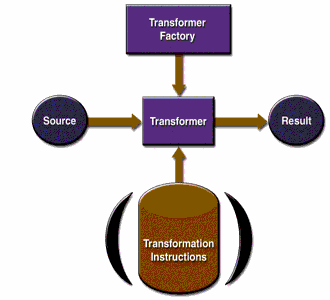Lesson: Introduction to JAXP
The Java Tutorials have been written for JDK 8. Examples and practices described in this page don't take advantage of improvements introduced in later releases and might use technology no longer available.
See Java Language Changes for a summary of updated language features in Java SE 9 and subsequent releases.
See JDK Release Notes for information about new features, enhancements, and removed or deprecated options for all JDK releases.
Extensible Stylesheet Language Transformations APIs
The following Figure shows the XSLT APIs in action.

A TransformerFactory object is instantiated and used to create a Transformer. The source object is the input to the transformation process. A source object can be created from a SAX reader, from a DOM, or from an input stream.
Similarly, the result object is the result of the transformation process. That object can be a SAX event handler, a DOM, or an output stream.
When the transformer is created, it can be created from a set of transformation instructions, in which case the specified transformations are carried out. If it is created without any specific instructions, then the transformer object simply copies the source to the result.
XSLT Packages
The XSLT APIs are defined in the packages shown in Table .
|
Package |
Description |
|---|---|
|
javax.xml.transform |
Defines the TransformerFactory and Transformer classes, which you use to get an object capable of doing transformations. After creating a transformer object, you invoke its transform() method, providing it with an input (source) and output (result). |
|
javax.xml.transform.dom |
Classes to create input (source) and output (result) objects from a DOM. |
|
javax.xml.transform.sax |
Classes to create input (source) objects from a SAX parser and output (result) objects from a SAX event handler. |
|
javax.xml.transform.stream |
Classes to create input (source) objects and output (result) objects from an I/O stream. |